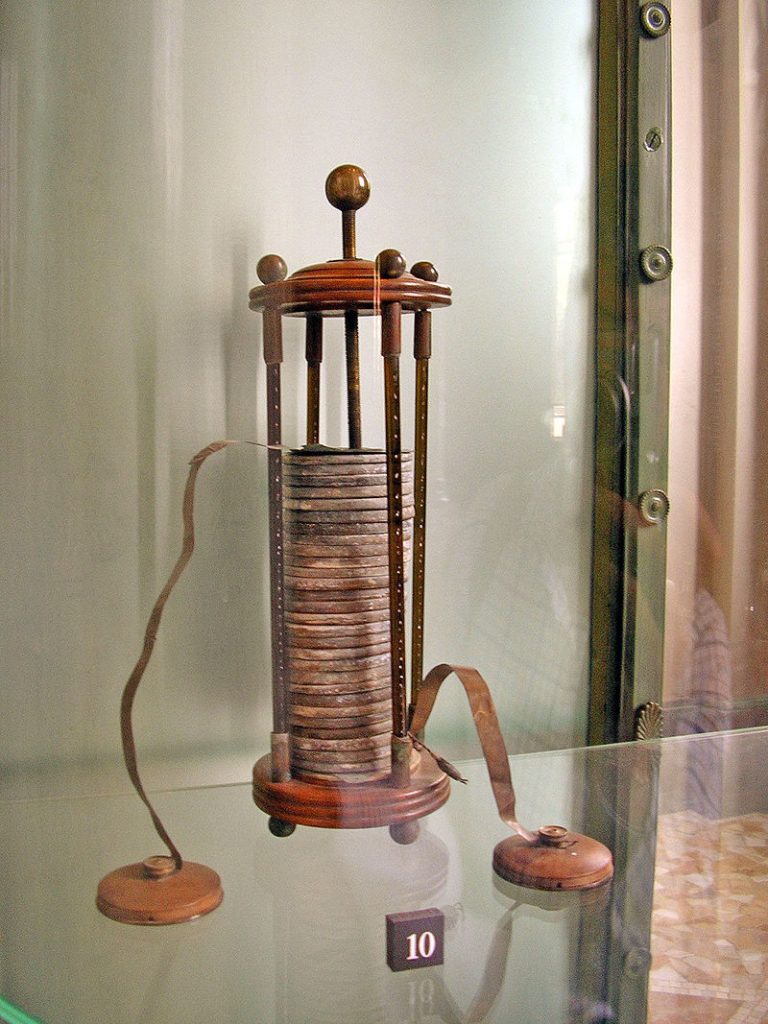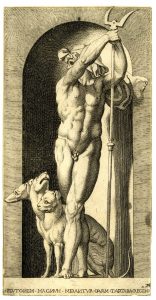Can you imagine a day without a battery? All our devices from smartphones to pacemakers use the power of batteries to harness electricity. These devices play a pivotal role in our society and it is important to give credit where credit is due. You can thank the great Italian scientist Alessandro Volta for his discovery of the first ever battery coined the voltaic pile. If his name sounds a bit familiar it is because the volt (unit for electric potential) is named after him.

Alessandro Volta was born to an aristocratic family in Como, Italy on February 18th, 1745.1 Volta excelled in math and science at a very young age. Even as a school boy he showed a keen interest in electricity. In the eighteenth century, the phenomenon of electricity was an intellectual curiosity, and not much was known about its properties. Volta excelled in school, and in 1774 he became a professor of physics at the Royal School of Como.2 During his time as professor, his interest in electricity remained a focus of his work. He created the electrophorus, which was a device used to generate static electricity.
Volta never set out to invent the battery. His experiments on electricity were in response to the claims of a scientist and friend of his, who claimed to have found electricity in animals.3 This scientist was Luigi Galvani, a professor of anatomy at the University of Bologna. One day as Galvani was performing an experiment on frogs, he began to cut the legs so that they would be exposed. When he touched his steel scalpel with a brass hook holding the frog’s legs in place, he saw the legs twitch. Galvani was convinced that what was going on was the presence of animal electricity. Galvani thought the muscles of the frog stored its life force. When Volta learned about Galvani’s discovery of animal electricity, he went right away to try to replicate Galvani’s experiment. Volta wanted to see for his own eyes what Galvani had published to the scientific community about his new discovery. After completing the experiment dozens of times, Volta disagreed with Galvani. Volta believed that the movement of the frog legs were because of the electric stimulation that was provided by the steel scalpel and the brass hook.4 Volta concluded that the frog’s legs were merely a vessel for the electric stimulation.

Once Volta recreated Galvani’s experiment, he knew the key to producing electricity was by using two metals that were not the same and not the actual frog legs themselves. The frog legs could not produce any sort of electricity. The reason the frog legs would move was because of the charge which was sent through the frog legs and into the nerves inside the legs which in turn resulted in a twitch. This was an indication that electricity was present. Volta recreated the experiment but would later conclude the frog legs were not the only electricity indicators but so were other materials such as moist cards of brine, or cardboard soaked in salt water. This was when Galvani concluded that the electric charge came from the rods of metal themselves and had nothing to do with frog legs. For the first experiment he used five cups with brine or salt water in them. Then, by adding pieces of silver and zinc, he attached the cups by metal strips where he placed them into the cups of brine. He would then put one finger at each end of the cups to feel the slight electric shock. Impressed with his work, he wanted to see if he could recreate his experiment, but without all the brine water. He then created a circuit consisting of copper and zinc discs that were separated by a cardboard soaked in brine. Just by adding more copper, cardboard soaked in brine, and zinc, Volta was able to adjust the amount of electricity that was being produced by the circuit. This became the voltaic pile, the first battery with a reliable source of electricity. Once Volta realized what he had done, he was able to refute the idea Galvani proposed about animal electricity.

Volta published his experiment and findings to the scientific community and later was honored for his invention of the voltaic pile. Today it is now almost impossible to not be in constant contact with a battery. You can thank Alessandro Volta for his discovery of the battery, which became a template for our modern dry-cell batteries. We might also thank Luigi Galvani for his role in stimulating Volta’s experiments, and maybe even thank the many nameless frogs for their contributions.
- Oliver J. Thatcher, The Library of Original Sources (New York, Chicago: University Research Extension, 1907), 395. ↵
- Encyclopedia of World Biography, 2004, s.v. “Alessandro Volta,” by Paula K. Byers. ↵
- Joost Mertens, “Shocks and Sparks: The Voltaic Pile as a Demonstration Device,” The History of Science Society 89, no. 2 (June 1998): 303. ↵
- Giuliano Pancaldi, Volta: Science and Culture in the Age of Enlightenment (Princeton University Press, May 1, 2005), 110. ↵



51 comments
Noah Laing
The title of this article was certainly intriguing, as was the article itself. It’s interesting to see that Volta believed the frog legs contained electricity because his friend and other scientist’s believed they found electricity in animals. It’s also interesting to see where his mindset and curiosity took him and that he wasn’t even originally trying to invent the battery in the first place, yet he still found away to make a technological advancement that would change the future of electricity and power, informative article.
Anais Del Rio
The battery is one of the most important inventions to mankind. Without the battery we wouldn’t have been able to create technology because it needed an endless supply of energy to power it. I can see why Galvani thought that the frog legs had electricity since it moved but only when the different metals were connected, but the same thing happens when you sprinkle salt onto the muscles they twitch from the reaction.
Tyler Thompson
It’s crazy to think that Volta thought that electricity came from an animal itself, rather than him producing the electricity. The process, and all the equipment needed must have taken some time to acquire or it must have been difficult to know which materials would go good together to preserve electricity in one item. We have Volta to thank for the ability to innovate off of this product.
Christopher King
I enjoyed this article very much because it went into detail about how he discovered how electricity is conducted and what is able to conduct electricity. Although it is an awful thing to use animals whether dead or alive, this experiment on a frog or probably many frogs led to one of the greatest achievements in human history that has advanced everything we know today in ways we could never imagine. This is one thing that I use everyday that I have never known about how it came about.
Natalia Carroll-Long
This is a very interesting article especially because I never knew the history of Volta. I really love it when scientist don’t really mean to create something, but do. It really shows the inevitability of progression. Aside from that, I would have never known frog legs were the cause of batteries being created. There’s just so much that one can learn from nature.
Michael Thomas
I found this article interesting because of how it details the creation of the battery. I did not know that Alessandro Volta created the battery and conducted an experiment with it on frog legs. Volta’s discovery of the battery has become essential for use because it allows us to carry devices without having to drag around a wire everywhere. Overall, this article was good.
Tyler Sleeter
Great article with lots of information. It always surprises me to read about scientists that discover things either by accident or in the process of looking for something else. This seems to be the case with Volta’s battery which he discovered while experimenting on frogs. It is also interesting to me that Volta set out to refute experiments on electricity done by Galvani. It is a shame that so many frogs had to be sacrificed to help Volta, but the battery is a significant discovery for humanity.
Destiny Flores
It’s crazy how something such as the battery is taken for granted everyday. I never knew the story behind electricity and yet, every part of my life revolves around it. I find it so fascinating that frogs had such involvement and that the name of volts themselves hold their story and I didn’t even know. Really informative article! The images also helped to picture the genius behind everything.
Elias Garza
The article’s title grabbed my attention and little did I know how literal it meant. I never would have thought that frog legs were a big part of how batteries were invented. I find it mind blowing. Also, this article does a great job with adding an image within the writing. The author gave much detail about how batteries came about and never lost focus on the main point.
Cristian Medina-Lopez
I agree how batteries are a huge part of our lives today and how his invention helped us move forward in our technological advancements. I found it interesting how he was able to figure out how sending the charges through the frog legs, it would twitch since it was in contact with its nerves. Which is what brought me to this article, the eye-catching title with frogs in it.